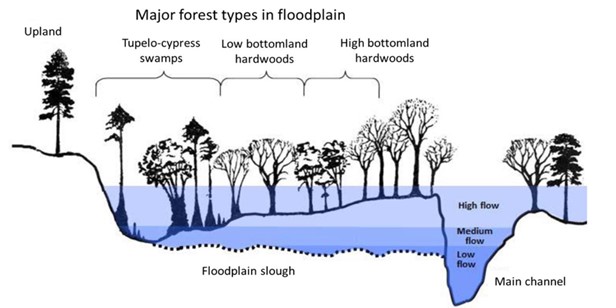Building Models to Forecast the Future
Models provide incredible opportunities to forecast how things like climate, spat fall, water quality, and management, among other things, are likely to influence restoration of oyster reefs in the Apalachicola Bay System.
 The ABSI modeling team for this project is developing a set of three different models, each component of which informs the next model in sequence: (Model No. 1) a hydrologic model of water flow and nutrients entering the Apalachicola Bay from the river, focusing on climate, water use, and water management (Steve Leitman, FSU); (Model No. 2) a hydrodynamic model focusing on water entering the bay from the Gulf of America and its effects on water quality (e.g., responses of the Bay to variability in freshwater input and atmospheric forcing), forming the basis for the model describing larval transport between oyster reefs and nearby estuaries (Steve Morey, FAMU); and (Model No. 3) an oyster model focusing on water, management and restoration in terms of oyster populations and fisheries (Ed Camp, University of Florida).
The ABSI modeling team for this project is developing a set of three different models, each component of which informs the next model in sequence: (Model No. 1) a hydrologic model of water flow and nutrients entering the Apalachicola Bay from the river, focusing on climate, water use, and water management (Steve Leitman, FSU); (Model No. 2) a hydrodynamic model focusing on water entering the bay from the Gulf of America and its effects on water quality (e.g., responses of the Bay to variability in freshwater input and atmospheric forcing), forming the basis for the model describing larval transport between oyster reefs and nearby estuaries (Steve Morey, FAMU); and (Model No. 3) an oyster model focusing on water, management and restoration in terms of oyster populations and fisheries (Ed Camp, University of Florida).
Dr. Steve Leitman (FSU, adjunct) has worked in the Apalachicola basin for over 40 years for federal and state government organizations as well as for several NGO's. On the ABSI project Dr. Leitman is evaluating fresh water inflow to the Apalachicola estuary under a range of reservoir management scenarios and alternate climate scenarios (Model No. 1). He is working closely with U. S. Army Corps of Engineers modelers to ensure model coordination. For more about the hydrologic model, see "Freshwater Inflow Modelling".
Dr. Steve Morey (Florida A&M NOAA Center for Coastal & Marine Ecosystems) is a physical oceanographer working with ABSI to characterize the reciprocal transfers of water that occur between Apalachicola Bay and the Gulf of America (Model No. 2).
Dr. Edward Camp (University of Florida Fisheries & Aquatic Sciences) is an interdisciplinary scientist who focuses on the ecology and human dimension aspects of managing fisheries & aquaculture. He will develop socioecological and spatially explicit oyster population models that will be used to evaluate management and restoration options under different environmental conditions.
Apalachicola Bay Salinity Models
Dr. Morey created the two animations shown below, which depict the flow and mixing of fresh (blue) and salt (water) in this system, to illustrate the differences between a year in which there was greater freshwater input (1998, a wetter year) and one in which there was less freshwater input (2000, a drier year). In each image, the bar on the right represents color coding for salinity ranges. This information can be used in concert with biological data to understand how physical and biological characteristics of the system interact and vary over time.
To see the models in motion, click the images. They can both run at the same time.

